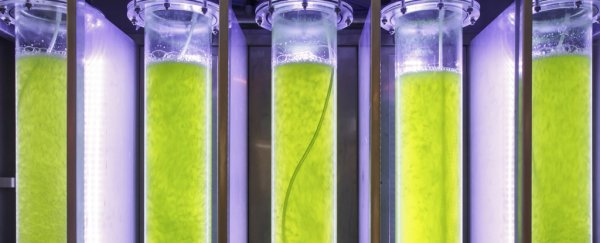Scientists have created a strain of algae that produces twice as much lipid as its wild parent, a substance that can be processed into a biofuel.
By using a combination of gene editing tools, including the famed CRISPR-Cas9 technique, they identified and switched off genes that limited the production of lipids. Creating an alga that can pump out commercial amounts of sustainably obtained biofuels.
"We are focused on understanding how to maximize the efficiency of [lipid production] algae and at the same time maximise the amount of CO2 converted to lipids in the cells, which is the component processed into biodiesel," Eric Moellering, lead researcher from company Synthetic Genomics Inc, told ScienceAlert.
Scientists have been trying to make the concept of using phototropic algae to produce bio-diesel a reality since the 1970s. In the past, it has been said that a new energy sector based on algal biofuels could guarantee transport fuel and food security far into the future.
Despite years of research, the best attempts until now have been limited to industrial strains which, although they have a really high lipid conversion rate, do not make sufficient amounts of lipid to make it commercially viable – limited by the fact it can't grow very fast.
"Early in the [study] we posed the basic question, can we engineer an alga to produce more lipids while sustaining growth? This publication provides the proof of concept answer to that question is yes," said Moellering.
In this new research, the team used CRISPR-Cas9, among other editing techniques, and identified 20 transition factors that regulated lipid production. By knocking out 18 of these, the team were able to double the lipid output compared to the non-modified algae.
But here's the important bit: they were able to do so without stunting the alga's growth rate. It grew at the same rate as the unmodified type.
The genetically modified algae produced up to 5 grams of lipid per metre per day, about twice as much as in the wild.
Another important metric is the total carbon to lipid conversion. This tells us how efficient the algae is at converting CO2 to lipids. In wild, unmodified alga the conversation rate is about 20 percent, but in the engineered alga it converted 40 to 55 percent of carbon to lipids.
It's worth pointing out that this study was only performed at the laboratory scale but one of the researchers, Imad Ajjawi, also from Synthetic Genomics, told ScienceAlert that while they consider this a 'proof of concept', "they represent a significant milestone in establishing the foundation for a path that leads to eventual commercialisation of algal biofuels."
Should this research graduate from the lab, bio-fuel production would no longer be reliant on sugars produced by land-grown crops like sugar cane and maize. Studies on the use of crop based biodiesel has shown that it could prove to be incredibly costly and damage our food security.
This research is another win for gene editing and the researchers have shown that new genetic editing tools sit at the centre of talking some of the world's biggest problems.
"We have also developed the necessary genomic and genetic tools that will enable future breakthroughs to advance this field," said Ajjawi.
The study has been published in Nature Biotechnology.
